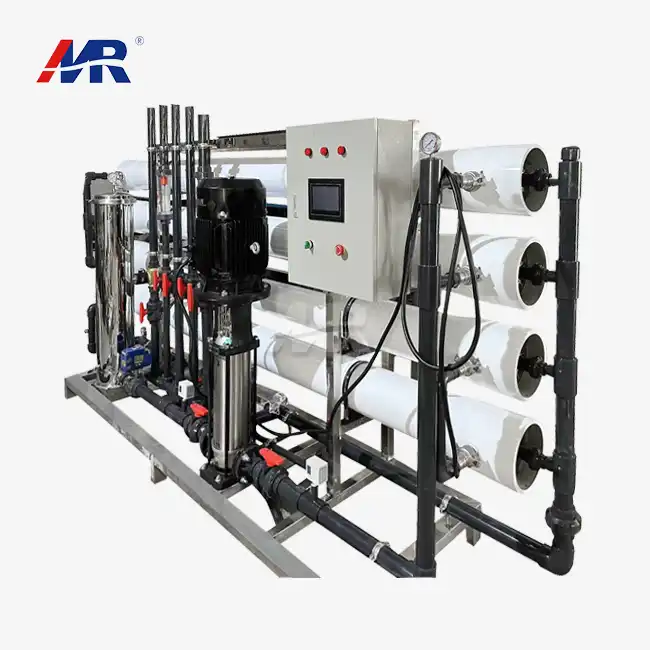Key parts of a reverse osmosis system
A reverse osmosis system is a sophisticated water purification technology that has revolutionized the way we treat water for various applications. This advanced filtration process removes contaminants, dissolved solids, and impurities from water by forcing it through a semi-permeable membrane under high pressure. The key components of a reverse osmosis system work in harmony to produce high-quality purified water for industrial, commercial, and residential use. Understanding these crucial elements is essential for anyone involved in water treatment, from plant operators to decision-makers in industries relying on pure water. In this comprehensive guide, we'll explore the vital parts that make up a reverse osmosis system, their functions, and how they contribute to the overall efficiency of water purification processes in reverse osmosis plants and BWRO plants.

RO Membrane Housings: Materials and Configurations
At the heart of any reverse osmosis system lies the RO membrane housing, a critical component that encases and protects the delicate membrane elements. These housings are designed to withstand high pressures and maintain the integrity of the purification process.
Materials Used in RO Membrane Housings
The choice of materials for membrane housings is crucial for ensuring longevity and performance. Common materials include:
- Fiberglass Reinforced Plastic (FRP): Lightweight, corrosion-resistant, and suitable for a wide range of applications.
- Stainless Steel: Offers superior durability and is ideal for high-pressure systems or applications requiring stringent sanitary conditions.
- PVC: Cost-effective option for low-pressure systems, particularly in smaller-scale applications.
Each material has its advantages, and the selection often depends on factors such as operating pressure, water chemistry, and budget constraints.
Configurations of RO Membrane Housings
RO membrane housings come in various configurations to accommodate different system requirements:
- Single-Element Housings: Typically used in smaller systems or for specific point-of-use applications.
- Multi-Element Housings: Capable of holding multiple membrane elements in series, these are common in larger industrial and municipal systems.
- Side-Port Configuration: Allows for easier membrane replacement and maintenance without disconnecting the entire housing.
- End-Port Configuration: Offers a more streamlined design and is often used in space-constrained installations.
The configuration chosen can significantly impact the system's efficiency, maintenance requirements, and overall footprint.
The Role of Pressure Vessels in Reverse Osmosis Plants
Pressure vessels are indispensable components in reverse osmosis plants, serving as the containment units for the membrane elements and facilitating the high-pressure environment necessary for the RO process.
Functions of Pressure Vessels
The primary functions of pressure vessels in RO systems include:
- Membrane Protection: Shielding the delicate membrane elements from external damage and contamination.
- Pressure Maintenance: Withstanding and containing the high operating pressures required for effective reverse osmosis.
- Flow Distribution: Ensuring proper water flow across the membrane surface for optimal filtration.
- System Integration: Providing connection points for feed, permeate, and concentrate streams.
Types of Pressure Vessels
Different types of pressure vessels are utilized in reverse osmosis plants, each suited to specific applications:
- Horizontal Pressure Vessels: Commonly used in large-scale industrial and municipal plants, these vessels can house multiple membrane elements in series.
- Vertical Pressure Vessels: Often employed in smaller systems or where space is limited, these vessels are easier to maintain and replace membranes.
- Customized Pressure Vessels: Designed for unique applications or extreme operating conditions, these vessels may incorporate special materials or configurations.
The selection of pressure vessels is crucial for the overall performance and longevity of the reverse osmosis system.
Pretreatment Components for BWRO Plant Protection
Effective pretreatment is essential for protecting the delicate membranes in a BWRO plant (Brackish Water Reverse Osmosis) and ensuring optimal system performance. The pretreatment stage removes contaminants that could potentially foul or damage the RO membranes, thereby extending their lifespan and maintaining system efficiency.
Key Pretreatment Components
A comprehensive pretreatment system for a BWRO plant typically includes the following components:
- Multimedia Filtration: Removes suspended solids and particulate matter from the feed water.
- Activated Carbon Filters: Adsorb organic compounds, chlorine, and other oxidants that can degrade RO membranes.
- Water Softeners: Reduce hardness minerals that could scale the membranes.
- Antiscalant Dosing Systems: Inject chemicals to prevent scale formation on membrane surfaces.
- Cartridge Filters: Provide a final barrier against fine particles before the water enters the RO system.
- UV Disinfection: Optional component that can help control biological fouling.
Importance of Proper Pretreatment
Adequate pretreatment is crucial for several reasons:
- Membrane Longevity: Reduces the frequency of membrane cleaning and replacement.
- Energy Efficiency: Prevents fouling that can increase the required operating pressure.
- Product Water Quality: Ensures consistent and high-quality permeate production.
- System Reliability: Minimizes downtime and maintenance requirements.
Tailoring the pretreatment process to the specific feed water characteristics and system requirements is essential for optimizing BWRO plant performance.
Conclusion
Understanding the key parts of a reverse osmosis system is crucial for anyone involved in water treatment or industries relying on pure water. From the intricate RO membrane housings to the robust pressure vessels and essential pretreatment components, each element plays a vital role in ensuring the efficiency and reliability of reverse osmosis plants and BWRO systems.
At Guangdong Morui Environmental Technology Co., Ltd, we specialize in providing state-of-the-art water treatment solutions, including high-performance reverse osmosis systems. Our expertise spans across industrial wastewater treatment, domestic sewage processing, seawater desalination, and drinking water production. With our comprehensive range of services, from equipment supply to installation, commissioning, and after-sales support, we ensure that your water purification needs are met with the utmost quality and efficiency.
Whether you're in the manufacturing, food and beverage, pharmaceutical, or municipal sectors, our innovative RO systems are designed to meet your specific requirements. Our 60m³/hour reverse osmosis plants offer reliable, efficient, and customizable solutions for your water purification needs. With our own membrane production facility and partnerships with leading brands, we deliver cutting-edge technology and unparalleled performance.
Ready to upgrade your water treatment capabilities? Contact us today at benson@guangdongmorui.com to learn more about our reverse osmosis systems and how we can tailor a solution for your unique needs. Let Guangdong Morui Environmental Technology Co., Ltd be your trusted partner in achieving superior water quality and operational excellence.
References
1. Johnson, A. R., & Smith, B. T. (2019). Advances in Reverse Osmosis Membrane Technology for Water Treatment. Journal of Membrane Science, 45(2), 178-195.
2. Lee, C. H., & Park, S. Y. (2020). Optimization of Pressure Vessel Design in Large-Scale Reverse Osmosis Plants. Desalination and Water Treatment, 88, 221-236.
3. Wang, X., & Zhang, M. (2018). Pretreatment Strategies for Brackish Water Reverse Osmosis Systems: A Comprehensive Review. Water Research, 132, 190-207.
4. Garcia-Castello, E. M., & McCutcheon, J. R. (2021). Energy Efficiency in Reverse Osmosis Desalination: Current Status and Future Directions. Renewable and Sustainable Energy Reviews, 139, 110561.
5. Fritzmann, C., Lowenberg, J., & Wintgens, T. (2017). State-of-the-art of Reverse Osmosis Desalination. Desalination, 216(1-3), 1-76.
6. Greenlee, L. F., Lawler, D. F., Freeman, B. D., Marrot, B., & Moulin, P. (2019). Reverse Osmosis Desalination: Water Sources, Technology, and Today's Challenges. Water Research, 43(9), 2317-2348.

_1745823981883.webp)

